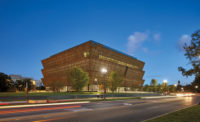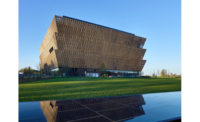Though the scaffolding on the National Museum of African American History and Culture’s new building on the Mall in Washington, D.C., has been down for some time, allowing the public full view of its three-tiered, crown-shaped exterior of bronze-colored cast-aluminum panels, on May 12, a small group of journalists was given a tour of its nearly complete interiors, where installation of exhibits has commenced. Representatives from the four firms collaborating on its design—jointly known as Freelon Adjaye Bond/Smith GroupJJR—as well as museum leaders and curators were on hand to discuss the project before the final push to complete construction in anticipation of the museum’s September 24th opening and ribbon-cutting by President Obama.
The building invites visitors first to descend 60 feet below grade to explore the story of slavery and freedom. The lower in the building you are, the further back in history the exhibit takes you. Large objects—including an antebellum slave cabin, a Tuskegee airplane, and a 44-seat segregation-era railway car that was dropped into the ramping exhibition hall before its ceiling was in place—anchor the visitor experience. A massive slurry wall, with quotations relating to the founding of America affixed to its stuccoed frontage, presides over the cavernous space. The entire foundation was redesigned and reengineered after construction had begun due to issues with the high water table on the swampy land, the last parcel available on the Mall.
Above grade, the building rises 60 feet, with light filtering into glass-walled galleries through the facade’s decorative screen, the pattern derived from historical ones made by renowned black ironworkers in Savannah and Charleston. These galleries celebrate the African-American contribution to music, theater, film, television, and the visual arts. Bigger artifacts, including a red Cadillac belonging to Chuck Berry and George Clinton’s Mothership—a 1,200-pound aluminum stage prop—have been installed but are under wraps for now. Smaller display cases with names of artists such as Prince and Ray Charles are mostly unfilled at this point, though images of one controversial inclusion, Bill Cosby, stood out.
At the highest level is a terrace-like lookout facing west over the city and toward the Washington Monument (unfortunately, metal panels of the facade’s top tier lop off views of the obelisk’s pinnacle). “This is a critical moment to reflect,” says lead designer David Adjaye.
Other main spaces include the Oprah Winfrey Theater, where panels similar to those of the facade, but smaller and silver, clad its interior. “On the facade, they filter light; here, they filter sound,” says Freelon Group president Phil Freelon.
Most surprising is the central hall, not for what it includes but for what it is missing. A major part of the original design, a dense forest of thin wood columns, was to be suspended from the ceiling but didn’t survive cost-cutting measures. “That was the biggest disappointment,” admits Adjaye, who leaves open the possibility for its return.
The building, which Adjaye calls a “once-in-a-lifetime opportunity to design this kind of project on this kind of site,” has a handsome presence on the Mall, and is particularly striking in juxtaposition to the classical white buildings surrounding it. But with much of the interior still unfinished, the final impact of its design is yet to be seen.




















Post a comment to this article
Report Abusive Comment